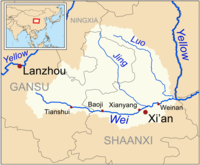
Photo from wikipedia
Inland lakes and rivers are large reservoirs of microplastics. But currently, not too much research was done on microplastics of mountain rivers. The protection of water sources from microplastics is… Click to show full abstract
Inland lakes and rivers are large reservoirs of microplastics. But currently, not too much research was done on microplastics of mountain rivers. The protection of water sources from microplastics is extremely significant for the safety of human drinking water. We quantified the distribution and variation of microplastics in the surface water from tributary (upstream water-source regions) to main stream (human settlements) in the Chin Ling-Wei River Plain Rivers, and assessed the pollution risk. Rivers in the Chin Ling-Wei River Plain contained various levels of microplastics (2.30-21.05 items/L), and the main stream of the river contained higher concentrations most commonly of microplastics than tributaries. The microplastics were fragments and films; they constituted 82.3% of the total abundance of microplastics. Microplastics with a particle size < 500 µm accounted for 64.3% of all the samples. As rivers flow from the mountains to the plains, the land-use types along the rivers become more multifunctional. Thus, the risk of river microplastic pollution increases sharply with distance downstream. Our research explored the microplastics pollution in the Chin Ling mountains based on topography and land-use types and thus provides a reference for further studies exploring the spatial distribution characteristics of microplastics in small-scale rivers and for pollution risk assessments.
Journal Title: Ecotoxicology and environmental safety
Year Published: 2022
Link to full text (if available)
Share on Social Media: Sign Up to like & get
recommendations!